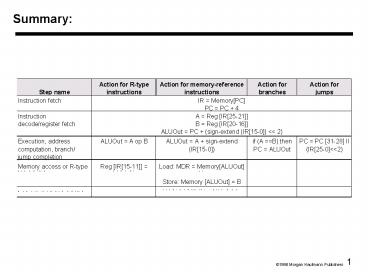Summary: - PowerPoint PPT Presentation
Title:
Summary:
Description:
Morgan Kaufmann Publishers. Implementation: Finite State Machine for Control. 6 ... Morgan Kaufmann Publishers. Complex instructions: the 'next state' is often ... – PowerPoint PPT presentation
Number of Views:24
Avg rating:3.0/5.0
Title: Summary:
1
Summary
2
Simple Questions
- How many cycles will it take to execute this
code? lw t2, 0(t3) lw t3, 4(t3) beq
t2, t3, Label assume not add t5, t2,
t3 sw t5, 8(t3)Label ... - What is going on during the 8th cycle of
execution? - In what cycle does the actual addition of t2 and
t3 takes place?
3
Implementing the Control
- Value of control signals is dependent upon
- what instruction is being executed
- which step is being performed
- Use the information weve acculumated to specify
a finite state machine - specify the finite state machine graphically, or
- use microprogramming
- Implementation can be derived from specification
4
Graphical Specification of FSM
- How many state bits will we need?
5
Finite State Machine for Control
- Implementation
6
PLA Implementation
- If I picked a horizontal or vertical line could
you explain it?
7
ROM Implementation
- ROM "Read Only Memory"
- values of memory locations are fixed ahead of
time - A ROM can be used to implement a truth table
- if the address is m-bits, we can address 2m
entries in the ROM. - our outputs are the bits of data that the address
points to.m is the "heigth", and n is
the "width"
0 0 0 0 0 1 1 0 0 1 1 1 0 0 0 1 0 1 1 0 0 0 1 1 1
0 0 0 1 0 0 0 0 0 0 1 0 1 0 0 0 1 1 1 0 0 1 1
0 1 1 1 0 1 1 1
8
ROM Implementation
- How many inputs are there? 6 bits for opcode, 4
bits for state 10 address lines (i.e., 210
1024 different addresses) - How many outputs are there? 16 datapath-control
outputs, 4 state bits 20 outputs - ROM is 210 x 20 20K bits (and a rather
unusual size) - Rather wasteful, since for lots of the entries,
the outputs are the same i.e., opcode is often
ignored
9
ROM vs PLA
- Break up the table into two parts 4 state bits
tell you the 16 outputs, 24 x 16 bits of
ROM 10 bits tell you the 4 next state bits,
210 x 4 bits of ROM Total 4.3K bits of ROM - PLA is much smaller can share product terms
only need entries that produce an active
output can take into account don't cares - Size is (inputs ? product-terms) (outputs ?
product-terms) For this example
(10x17)(20x17) 460 PLA cells - PLA cells usually about the size of a ROM cell
(slightly bigger)
10
Another Implementation Style
- Complex instructions the "next state" is often
current state 1
11
Details
12
Microprogramming
- What are the microinstructions ?
13
Microprogramming
- A specification methodology
- appropriate if hundreds of opcodes, modes,
cycles, etc. - signals specified symbolically using
microinstructions - Will two implementations of the same architecture
have the same microcode? - What would a microassembler do?
14
Microinstruction format
15
Maximally vs. Minimally Encoded
- No encoding
- 1 bit for each datapath operation
- faster, requires more memory (logic)
- used for Vax 780 an astonishing 400K of memory!
- Lots of encoding
- send the microinstructions through logic to get
control signals - uses less memory, slower
- Historical context of CISC
- Too much logic to put on a single chip with
everything else - Use a ROM (or even RAM) to hold the microcode
- Its easy to add new instructions
16
Microcode Trade-offs
- Distinction between specification and
implementation is sometimes blurred - Specification Advantages
- Easy to design and write
- Design architecture and microcode in parallel
- Implementation (off-chip ROM) Advantages
- Easy to change since values are in memory
- Can emulate other architectures
- Can make use of internal registers
- Implementation Disadvantages, SLOWER now that
- Control is implemented on same chip as processor
- ROM is no longer faster than RAM
- No need to go back and make changes
17
The Big Picture

